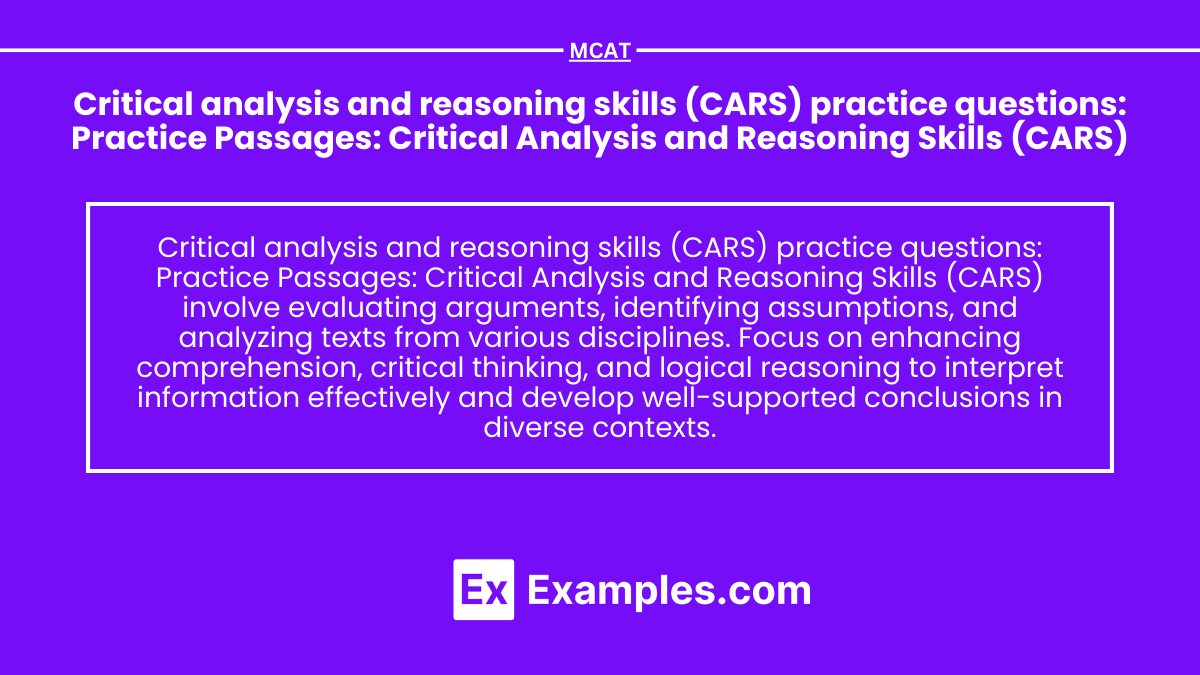Critical analysis and reasoning skills (CARS) practice questions: Practice Passages: Critical Analysis and Reasoning Skills (CARS)

- Notes
The Critical Analysis and Reasoning Skills (CARS) section of the MCAT tests reading comprehension, analysis, and reasoning through practice passages. To excel, students must develop strategies for quickly identifying main ideas, analyzing the author’s perspective, and answering questions accurately. Effective preparation involves regular practice, time management, and honing inference skills to maximize performance in this challenging section.
Learning Objective
In studying “Critical Analysis and Reasoning Skills (CARS): Practice Passages” for the MCAT, you should learn to develop skills in reading comprehension, analysis, and logical reasoning. Focus on understanding complex passages across various disciplines, identifying main ideas, and making inferences. Practice interpreting tone, argument structure, and assumptions in texts, and apply reasoning to evaluate conclusions and evidence. Enhance your ability to synthesize information, spot nuances, and answer questions based on critical thinking rather than prior knowledge. Additionally, refine time management strategies for tackling CARS passages effectively in a timed environment.
Understanding Passage Structure and Main Ideas

- Identify the Author’s Purpose: Determine whether the author is trying to inform, persuade, or entertain. This helps you grasp the overall tone and goal of the passage.
- Recognize Main Ideas and Themes: Pay close attention to topic sentences and conclusion statements. Try summarizing each paragraph to clarify the main ideas and how they support the passage’s overall message.
- Analyze Passage Organization: Note the logical flow of ideas and how they connect. Understanding the structure can aid in predicting where the author might go next or in answering questions that require an understanding of the passage as a whole.
Developing Active Reading Skills
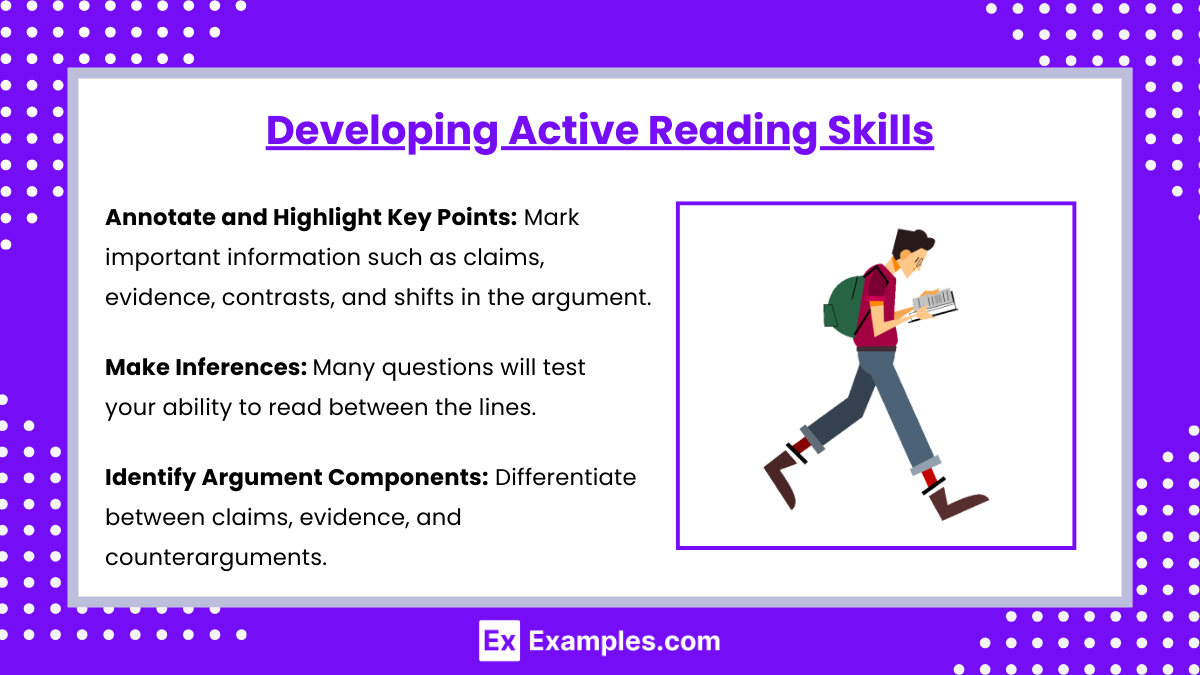
- Annotate and Highlight Key Points: Mark important information such as claims, evidence, contrasts, and shifts in the argument. These annotations can help you locate information quickly when answering questions.
- Make Inferences: Many questions will test your ability to read between the lines. Practice identifying implicit assumptions or inferring information that isn’t directly stated but can be logically deduced.
- Identify Argument Components: Differentiate between claims, evidence, and counterarguments. This understanding will help you answer questions about the author’s stance and the strength of their arguments.
Effective Passage Reading Strategies
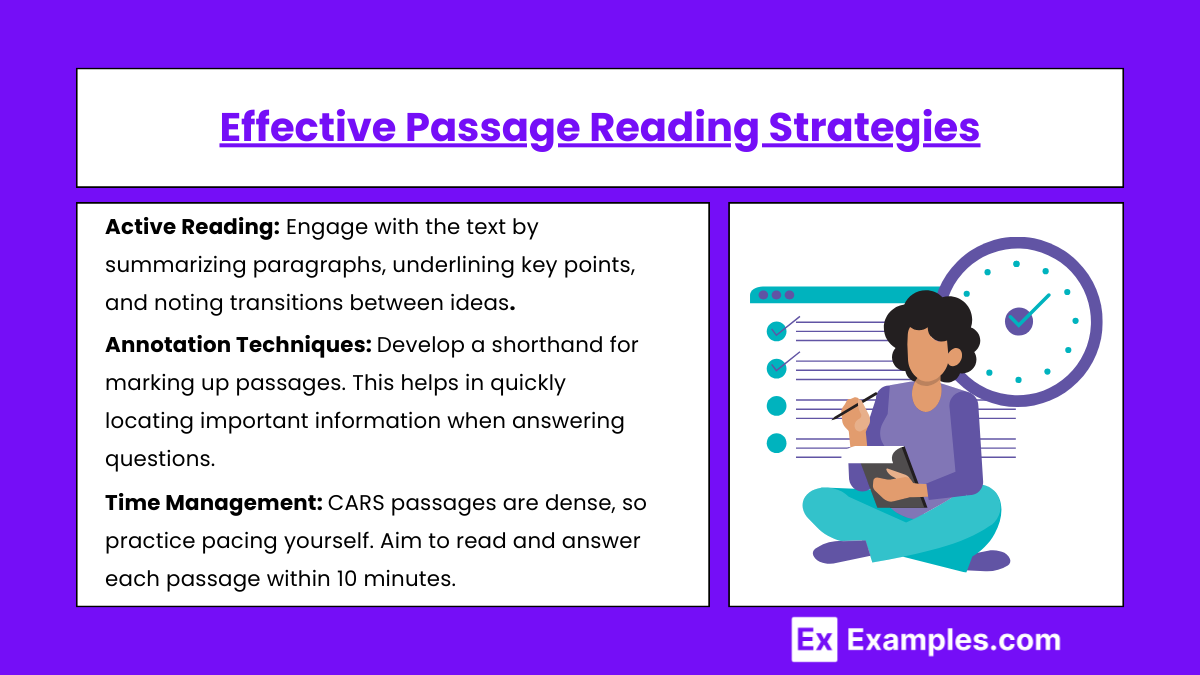
- Active Reading: Engage with the text by summarizing paragraphs, underlining key points, and noting transitions between ideas.
- Annotation Techniques: Develop a shorthand for marking up passages. This helps in quickly locating important information when answering questions.
- Time Management: CARS passages are dense, so practice pacing yourself. Aim to read and answer each passage within 10 minutes.
Building CARS Skills
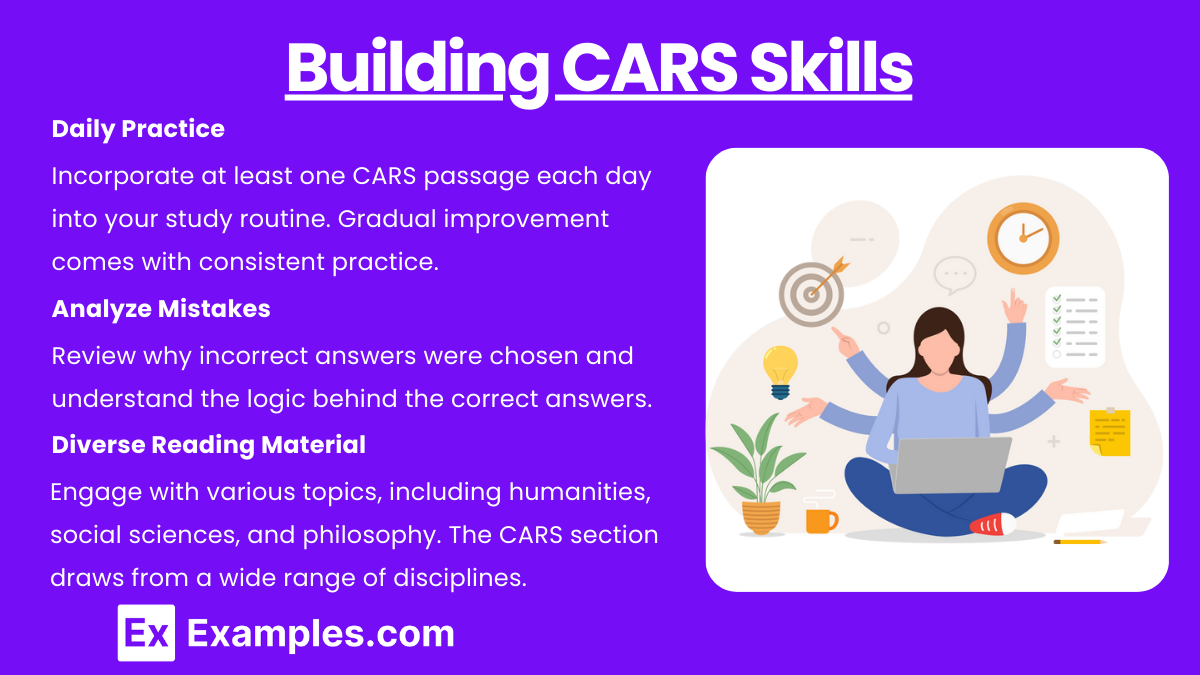
- Daily Practice: Incorporate at least one CARS passage each day into your study routine. Gradual improvement comes with consistent practice.
- Analyze Mistakes: Review why incorrect answers were chosen and understand the logic behind the correct answers.
- Diverse Reading Material: Engage with various topics, including humanities, social sciences, and philosophy. The CARS section draws from a wide range of disciplines.
Reading and Comprehension Techniques
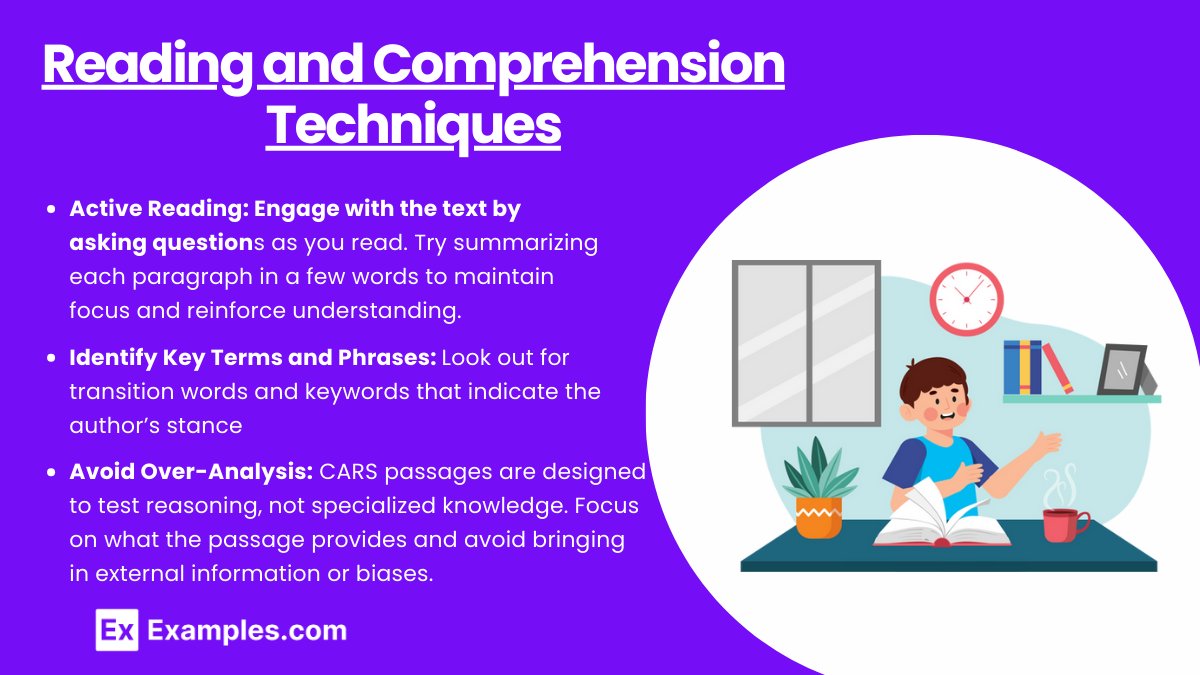
- Active Reading: Engage with the text by asking questions as you read. Try summarizing each paragraph in a few words to maintain focus and reinforce understanding.
- Identify Key Terms and Phrases: Look out for transition words (e.g., however, therefore, furthermore) and keywords that indicate the author’s stance (e.g., important, unfortunately, suggests).
- Avoid Over-Analysis: CARS passages are designed to test reasoning, not specialized knowledge. Focus on what the passage provides and avoid bringing in external information or biases.
Examples
Example 1: Main Idea Question
After reading a passage discussing the impacts of climate change, you might be asked, “What is the author’s main argument regarding climate change?” This question requires you to identify the central theme or purpose of the passage. The main idea often surfaces in the introductory or concluding paragraphs.
Example 2: Detail Question
In a passage describing various theories of human motivation, a question could be, “What role does intrinsic motivation play according to the author?” This question requires locating specific information within the text. The answer is typically found within the passage’s supporting details or examples.
Example 3: Inference Question
If a passage explores ethical dilemmas in medical research, you might be asked, “What can be inferred about the author’s stance on ethical guidelines?” This question demands interpreting implied meanings based on context clues. Analyzing tone and word choice can help uncover subtler points.
Example 4: Function Question
In a passage about historical figures, you might see, “Why does the author mention Albert Einstein’s discoveries?” This type of question asks you to understand why a particular example or detail was included, often to support a broader argument or illustrate a concept.
Example 5: Tone Question
For a passage discussing advancements in technology, you could be asked, “Which word best describes the author’s attitude toward technological progress?” Here, you need to assess the author’s emotional stance by examining the language and expressions used, helping you to understand the passage’s overall tone.=
Practice Questions
Question 1:
Passage Summary: The author discusses the history of urban development, focusing on how cities have been designed to prioritize car travel over pedestrian-friendly spaces.
What is the author’s primary purpose in the passage?
A) To argue that pedestrian-friendly cities are more sustainable.
B) To highlight the benefits of car-centric urban planning.
C) To explain the evolution of urban design with a focus on car travel.
D) To advocate for increased funding for public transportation.
Answer: C) To explain the evolution of urban design with a focus on car travel.
Explanation: This question asks about the author’s primary purpose. While the passage mentions car-centric urban planning, it is focused on explaining how urban design evolved in this way, rather than advocating for or against any particular approach. Option C captures this purpose accurately, whereas Option A and D imply advocacy that is not necessarily supported by the summary.
Question 2:
Passage Summary: The author criticizes the excessive use of plastic in packaging and the resulting environmental harm, but also acknowledges recent efforts to reduce plastic waste.
Which of the following best describes the tone of the passage?
A) Optimistic
B) Sarcastic
C) Cautiously hopeful
D) Neutral
Answer: C) Cautiously hopeful
Explanation: The tone of the passage is cautiously hopeful, as the author criticizes plastic use but also recognizes positive steps towards reducing waste. This implies a balanced perspective, seeing both the problem and some solutions. Option A (Optimistic) is too positive, while Option B (Sarcastic) does not match the description. Option D (Neutral) does not reflect the author’s evident concern.
Question 3:
Passage Summary: The author argues that traditional education methods may not be effective for all students, advocating for more personalized learning approaches.
Which of the following assumptions underlies the author’s argument?
A) All students learn better in traditional classroom settings.
B) Personalized learning approaches are more difficult to implement than traditional methods.
C) Different students have unique learning needs that may not be met by traditional methods.
D) Teachers prefer traditional teaching methods over personalized approaches.
Answer: C) Different students have unique learning needs that may not be met by traditional methods.
Explanation: The author’s argument is based on the idea that traditional methods do not work for all students, which implies that students have unique learning needs. Option C directly reflects this assumption. Options A and D contradict the argument, and Option B, while possible, does not align directly with the assumption underlying the argument.
The Critical Analysis and Reasoning Skills (CARS) section of the MCAT tests reading comprehension, analysis, and reasoning through practice passages. To excel, students must develop strategies for quickly identifying main ideas, analyzing the author’s perspective, and answering questions accurately. Effective preparation involves regular practice, time management, and honing inference skills to maximize performance in this challenging section.
Learning Objective
In studying "Critical Analysis and Reasoning Skills (CARS): Practice Passages" for the MCAT, you should learn to develop skills in reading comprehension, analysis, and logical reasoning. Focus on understanding complex passages across various disciplines, identifying main ideas, and making inferences. Practice interpreting tone, argument structure, and assumptions in texts, and apply reasoning to evaluate conclusions and evidence. Enhance your ability to synthesize information, spot nuances, and answer questions based on critical thinking rather than prior knowledge. Additionally, refine time management strategies for tackling CARS passages effectively in a timed environment.
Understanding Passage Structure and Main Ideas
Identify the Author’s Purpose: Determine whether the author is trying to inform, persuade, or entertain. This helps you grasp the overall tone and goal of the passage.
Recognize Main Ideas and Themes: Pay close attention to topic sentences and conclusion statements. Try summarizing each paragraph to clarify the main ideas and how they support the passage's overall message.
Analyze Passage Organization: Note the logical flow of ideas and how they connect. Understanding the structure can aid in predicting where the author might go next or in answering questions that require an understanding of the passage as a whole.
Developing Active Reading Skills
Annotate and Highlight Key Points: Mark important information such as claims, evidence, contrasts, and shifts in the argument. These annotations can help you locate information quickly when answering questions.
Make Inferences: Many questions will test your ability to read between the lines. Practice identifying implicit assumptions or inferring information that isn’t directly stated but can be logically deduced.
Identify Argument Components: Differentiate between claims, evidence, and counterarguments. This understanding will help you answer questions about the author’s stance and the strength of their arguments.
Effective Passage Reading Strategies
Active Reading: Engage with the text by summarizing paragraphs, underlining key points, and noting transitions between ideas.
Annotation Techniques: Develop a shorthand for marking up passages. This helps in quickly locating important information when answering questions.
Time Management: CARS passages are dense, so practice pacing yourself. Aim to read and answer each passage within 10 minutes.
Building CARS Skills
Daily Practice: Incorporate at least one CARS passage each day into your study routine. Gradual improvement comes with consistent practice.
Analyze Mistakes: Review why incorrect answers were chosen and understand the logic behind the correct answers.
Diverse Reading Material: Engage with various topics, including humanities, social sciences, and philosophy. The CARS section draws from a wide range of disciplines.
Reading and Comprehension Techniques
Active Reading: Engage with the text by asking questions as you read. Try summarizing each paragraph in a few words to maintain focus and reinforce understanding.
Identify Key Terms and Phrases: Look out for transition words (e.g., however, therefore, furthermore) and keywords that indicate the author’s stance (e.g., important, unfortunately, suggests).
Avoid Over-Analysis: CARS passages are designed to test reasoning, not specialized knowledge. Focus on what the passage provides and avoid bringing in external information or biases.
Examples
Example 1: Main Idea Question
After reading a passage discussing the impacts of climate change, you might be asked, “What is the author’s main argument regarding climate change?” This question requires you to identify the central theme or purpose of the passage. The main idea often surfaces in the introductory or concluding paragraphs.
Example 2: Detail Question
In a passage describing various theories of human motivation, a question could be, “What role does intrinsic motivation play according to the author?” This question requires locating specific information within the text. The answer is typically found within the passage’s supporting details or examples.
Example 3: Inference Question
If a passage explores ethical dilemmas in medical research, you might be asked, “What can be inferred about the author’s stance on ethical guidelines?” This question demands interpreting implied meanings based on context clues. Analyzing tone and word choice can help uncover subtler points.
Example 4: Function Question
In a passage about historical figures, you might see, “Why does the author mention Albert Einstein’s discoveries?” This type of question asks you to understand why a particular example or detail was included, often to support a broader argument or illustrate a concept.
Example 5: Tone Question
For a passage discussing advancements in technology, you could be asked, “Which word best describes the author’s attitude toward technological progress?” Here, you need to assess the author’s emotional stance by examining the language and expressions used, helping you to understand the passage’s overall tone.=
Practice Questions
Question 1:
Passage Summary: The author discusses the history of urban development, focusing on how cities have been designed to prioritize car travel over pedestrian-friendly spaces.
What is the author’s primary purpose in the passage?
A) To argue that pedestrian-friendly cities are more sustainable.
B) To highlight the benefits of car-centric urban planning.
C) To explain the evolution of urban design with a focus on car travel.
D) To advocate for increased funding for public transportation.
Answer: C) To explain the evolution of urban design with a focus on car travel.
Explanation: This question asks about the author's primary purpose. While the passage mentions car-centric urban planning, it is focused on explaining how urban design evolved in this way, rather than advocating for or against any particular approach. Option C captures this purpose accurately, whereas Option A and D imply advocacy that is not necessarily supported by the summary.
Question 2:
Passage Summary: The author criticizes the excessive use of plastic in packaging and the resulting environmental harm, but also acknowledges recent efforts to reduce plastic waste.
Which of the following best describes the tone of the passage?
A) Optimistic
B) Sarcastic
C) Cautiously hopeful
D) Neutral
Answer: C) Cautiously hopeful
Explanation: The tone of the passage is cautiously hopeful, as the author criticizes plastic use but also recognizes positive steps towards reducing waste. This implies a balanced perspective, seeing both the problem and some solutions. Option A (Optimistic) is too positive, while Option B (Sarcastic) does not match the description. Option D (Neutral) does not reflect the author's evident concern.
Question 3:
Passage Summary: The author argues that traditional education methods may not be effective for all students, advocating for more personalized learning approaches.
Which of the following assumptions underlies the author’s argument?
A) All students learn better in traditional classroom settings.
B) Personalized learning approaches are more difficult to implement than traditional methods.
C) Different students have unique learning needs that may not be met by traditional methods.
D) Teachers prefer traditional teaching methods over personalized approaches.
Answer: C) Different students have unique learning needs that may not be met by traditional methods.
Explanation: The author’s argument is based on the idea that traditional methods do not work for all students, which implies that students have unique learning needs. Option C directly reflects this assumption. Options A and D contradict the argument, and Option B, while possible, does not align directly with the assumption underlying the argument.

